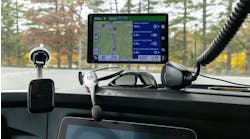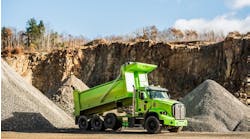A panel discussion at the recent American Trucking Associations (ATA) Management Conference & Exhibition (MC&E) in Philadelphia explored how telematics is going to change trucks and the trucking industry, largely by offering opportunities created by data analysis to reshape vehicles and operations for greater efficiencies.
“Connectivity is the biggest enabler of a lot of potential benefits for this industry,” argued Wallace Lau, an industry analyst with the automotive & transportation practice at global consulting firm Frost & Sullivan; benefits such as increased fuel economy, less vehicle downtime, higher productivity and – ultimately – trucks that drive themselves.
“There’s also a lot of money to made through offering more connected trucks,” he stressed, noting that his firm predicts some 35 million light, medium and heavy-duty trucks featuring some sort of telematics connectivity will be on the road by 2020.
Right now the “connectivity market” is worth $3.5 billion annually, Lau said, encompassing everything from better warranty management and maintenance prognostics to the ability to reduce empty mileage via Uber-like freight services – offerings that only represent “the tip of the iceberg” in terms of what telematics can offer trucking, he stressed.
Brian McLaughlin, president of PeopleNet, offered a similar assessment concerning the potential of telematics in trucking, noted that “four key drivers” will guide future telematics development:
- Deeper connections between commercial vehicles and the IoTT or “Internet of Transportation Things”
- More connected truck drivers via smart phone applications
- Moving from “big data” to “business intelligence”
- The convergence of data and video
“By 2020, it’s expected that there will be an average – an average, mind you – of seven devices per person: from smart phones and tablets to ‘fit bits’ and such,” McLaughlin stressed. “We’re looking at the potential one day to possibly equip truck drivers to monitor their heart rate, fatigue levels, and other health metrics in real time as they operate equipment.”
Of course, several major challenges need to be overcome in order to attain such capabilities, the biggest revolving around data privacy and security issues, he added.
Yet it is a future that draws ever closer, McLaughlin argued, as trucking continues to “rapidly adopt” telematics solutions, with such systems currently experiencing a growth rate of 20% to 25% per year.
“The ELD [electronic logging device] mandate is really going to reshape the market,” he pointed out. “Right now, it’s the larger fleets that have really adopted telematics technology in large measure, with the smaller fleets and owner-operators in ‘wait-and-see’ mode. But the ELD mandate changes all of that and will put telematics capability into their vehicles.”
To successfully extract value from telematics adoption – to go from “vapor to reality” successfully – McLaughlin said fleets should focus on four key points:
- Establish a game plan to achieve a solid return on investment (ROI)
- Pick a telematics “mobility” model that fits your business; there are a lot of choices
- Start with core applications needed for the business; don’t try to “boil the ocean’ and get everything at once
- Don’t buy “bleeding edge” but “leading edge” technology
Paul Menig, CEO of consulting firm Tech-I-M, added that telematics data should be able to help trucking create more beneficial operating conditions from itself – using data to highlight the benefits of operating nighttime schedules to avoid traffic congestion while improving fatigue monitoring capability.
PeopleNet’s McLaughlin echoed that conclusion, especially when it comes to monitoring hours of service (HOS) compliance.
“The way HOS is monitored today is antiquated,” he said. “Wearable technology would allow fleets and law enforcement to monitor fatigue on a real-time basis, as well as permit things such as alcohol/drug detection, insulin levels for diabetics, body health data from sleep apnea sufferers, etc.,” he said. “Yet it is privacy and legal issues that will need to be addressed with that; we’re years away from capabilities like that, even if they are ever allowed.”
Menig also highlighted results from an in-depth survey jointly conducted by the ATA’s Technology & Maintenance Council (TMC) and the American Transportation Research Institute (ATRI) with 32 executives at 31 fleets.
One interesting finding from that poll that most expect autonomous vehicles (AVs) to be the end result of such telematics development: a question of “when” not “if” to their minds. The real barrier for such technology, from the fleet perspective, is how AVs deal with weather and the resulting road conditions: ice, heavy rain, and major events such as Hurricanes.
Another major issue where telematics is concerned: the threat of hacking. Menig noted the recent hacking of a Chrysler-made Jeep at highway speed crystalized the threat to trucking in the minds of many fleet executives.
“There are differences that need to be noted with this [Jeep] situation, as hackers used an open-source IP [Internet Protocol] address and a direction connection between the satellite radio and the engine to achieve it,” he said. “But if it can happen to a car, it can happen to a truck.”
PeopleNet’s McLaughlin said it really means a more “layered” security approach to telematics will be needed, including extra “gateways” potential hackers would need to navigate and more robust security audits by fleets. “A new ‘ecosystem of security’ for telematics will need to be created,” he said.



